#Mount Stuart House
Photo

Green is the theme here. A quiet section of the Mount Stuart House gardens. This lane actually exits the property.
#original photography#original photographer#photographers on tumblr#green#driveway#gardens#mount Stuart house#isle of bute#scotland#island life#Rothesay#Marquees of Bute#gothic architecture#coal-mining#cardiff castle#UK#summer holidays
21 notes
·
View notes
Text
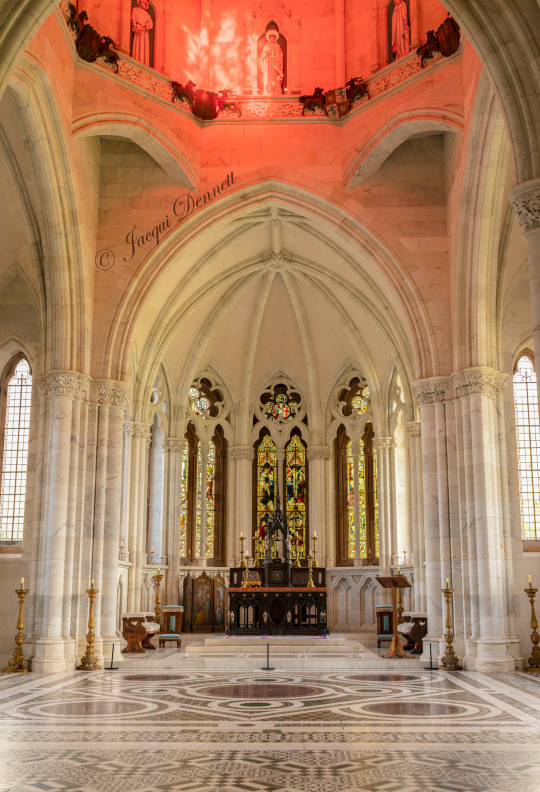
The chapel of Mount Stuart House
All the marble for the house was imported from mainland Italy / Scicily
The Chapel’s Cosmati flooring is typical of the architecture of Medieval Italy. The same style can be found in the Sistine Chapel and Westminster Abbey.
#hncphotoblog#hncphotography2022#hncphotography#location#mount stuart house#chapel#marble chapel#architeture
0 notes
Text


My art for the @mcytblraufest, of Bushranger/1850s Australia AU Cleo and Pearl!
Go check out @aliteral-ghost's fic for the art, it's really good: link.
Web Weave Credits: 'Waltzing Matilda' by Banjo Patterson' / 'The Man from Snowy River' by Banjo Patterson' / 'The Blind Assassin' by Margaret Atwood / Cultural Cringe on Wikipedia / Dingo photographed by Sam Fraser-Smith / 'The Anglel in The House' by Coventry Patmore / Zombie Cleo's Double Life Episode 1 / PearlescentMoon's Double Life Episode 1. / British Pattern 1853 Rifle by the Smithsonian / Ned Kelly's Armour at the State Library of Victoria / 'Ned Kelly's last words: 'Ah, well, I suppose'' by Stuart E Dawson / ZombieCleo's Double Life Episode 6 / 'Reminiscences of a Victoria Mounted Constable (A Narrative of the Kelly Gang and Other Bushrangers)' by Thomas McIntyre / 'Bushrangers on St Kilda Road' by William Strut / 'Bailed Up' by Tom Roberts / 'Bushrangers Attack a Gold Escort' by McFarlane and Erskine / 'Death of Ben Hall' by Patrick Maroney
25 notes
·
View notes
Text
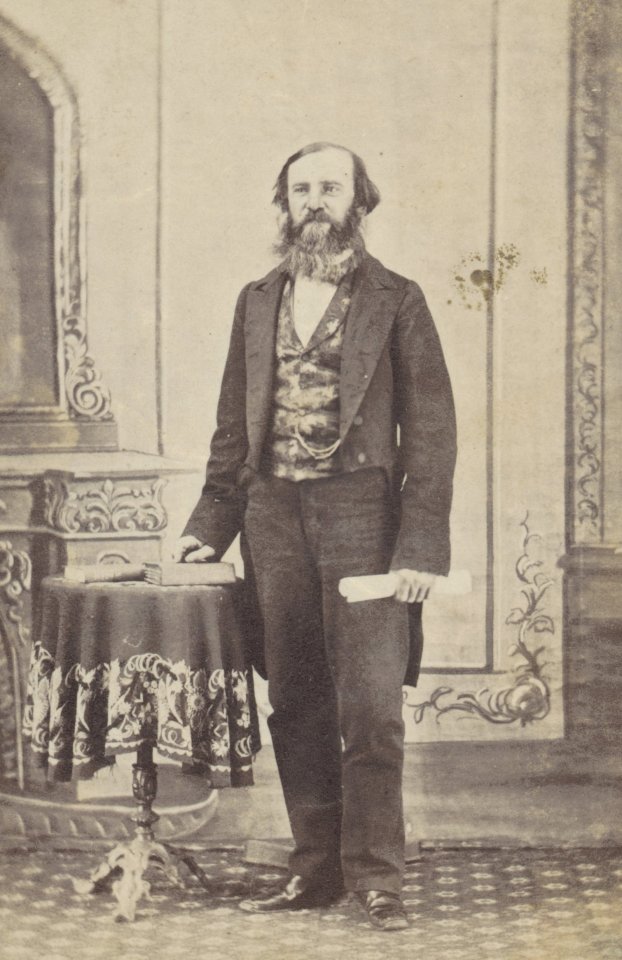
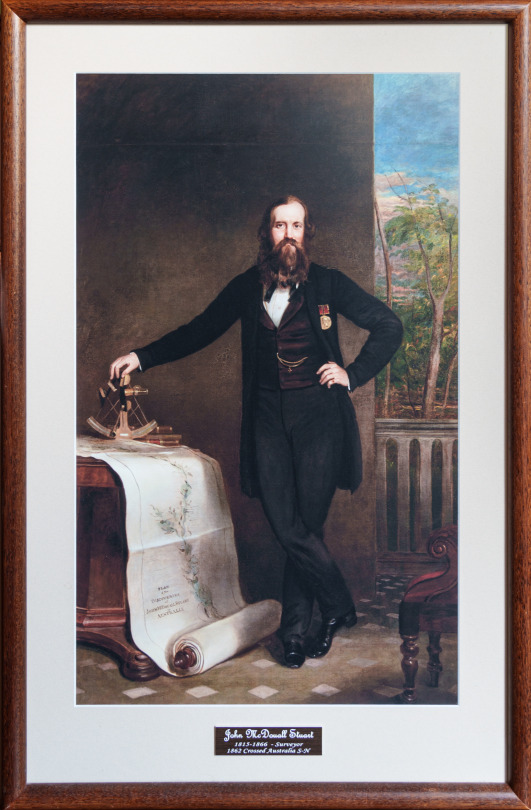


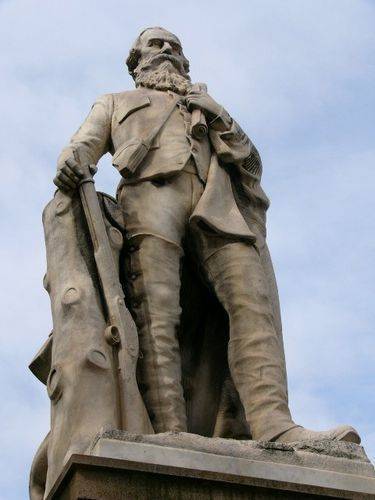
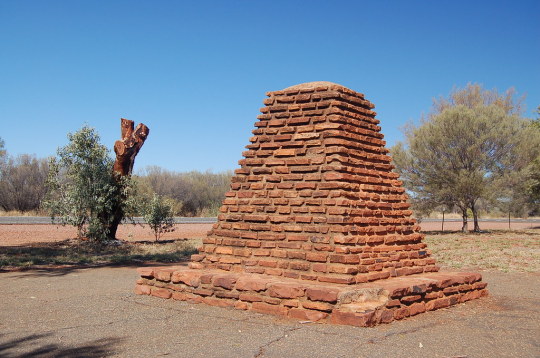
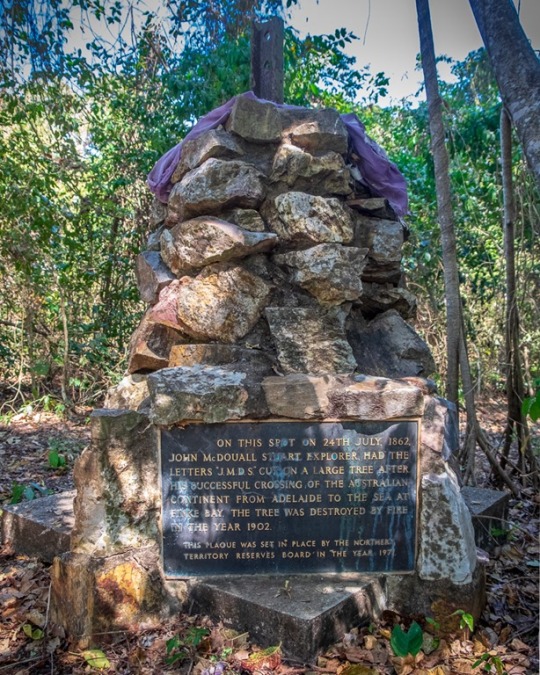
On September 7th 1815, explorer John McDouall Stuart was born in Dysart, Fife.
Descended from a family steeped in military service, Stuart was born in in a sixteenth-century home which now houses a museum in his honour, as seen in the pic. He was the son of army captain William Stuart and his wife Mary (née McDouall). Orphaned in his early teens, he attended the Scottish Naval and Military Academy, Edinburgh, and graduated as a civil engineer.
At the age of 23 he embarked on the Indus from Dundee, arriving at Holdfast Bay, South Australia, in January 1839. He entered the Government Survey Department and, despite primitive conditions in survey camps, found that nomadic life in the bush appealed to him. A man of small stature, his life became a constant battle against ill health and poverty. Assigned as draughtsman for the 1844-46 expedition of Captain Charles Sturt into the interior, Stuart gained valuable experience and received his leader’s full approbation. Sturt’s failure to reach the centre of the continent inspired Stuart’s later achievements.
Returning to Adelaide in January 1846, Stuart was incapacitated with scurvy for twelve months and moved to Port Lincoln for health reasons, while recovering he worked for fellow Scot and shipmate James Sinclair on his properties and tutored the Sinclair children.
In 1854 William Finke and the Chambers brothers, James and John, engaged him to survey leases and prospect for minerals in the northern Flinders Ranges. Between May 1858 and January 1860 Stuart led three expeditions into the Lake Eyre region, seeking new grazing lands and minerals for his sponsors.
In contrast to Sturt, Stuart travelled quickly with limited supplies. Horses were his only means of conveyance. On his first attempt to cross the continent, he reached the geographical centre of Australia on 22nd April 1860, accompanied by two companions and twelve horses --- a feat later described as ‘the greatest and pluckiest exploration ever accomplished’. He tried again the following year but it was not until 1862 that he finally made it to the northern shore.
In poor health Stuart returned to England in 1864, nearly blind and with a broken constitution. He died on 5th June 1866, a forgotten hero. He was buried at Kensal Green Cemetery, London, with a memorial stone erected by his sister Mary.
As a result of Stuart’s expeditions, the nature of the Red Centre was revealed, South Australia gained control of and settled the Northern Territory, and vast areas of the interior were opened up for European settlement. In 1872 the Adelaide-to-Darwin Overland Telegraph Line was completed along Stuart’s route.
His statue was erected in Victoria Square, Adelaide in 1904 and Central Mount Stuart, the Stuart Highway and Stuart Range are named in his honour. The John McDouall Stuart Society was founded in 1964 by descendants of his companions to perpetuate his name and achievements.
A second statue of Stuart can be found in Alice Spring. The statue has been hounded by controversy since it was gifted to the Alice Springs Town Council in 2010, with some saying the work is culturally insensitive. Protests accuse him of not asking permission to enter the land and of killing Arrernte people."You came to Mount Hay and you killed our mob," a letter from Aboriginal elders said. "You went to Attack Creek and you killed more of our mob. This is murder and we can't forget it." it continued.
The Australian Aboriginal singer Warren H Williams also spoke at a protest rally, mocking the size of the gun and calling for the statue to be removed.
"This fella has destroyed both Arrernte and Warramungu [people]...look at the statue, it's a big gun," he said.
"They put a statue up of him, but never asked anybody, even the white people in this town if they can put it up..."
There are numerous memorials to Stuart around South Australia.
8 notes
·
View notes
Text
Mount Stuart


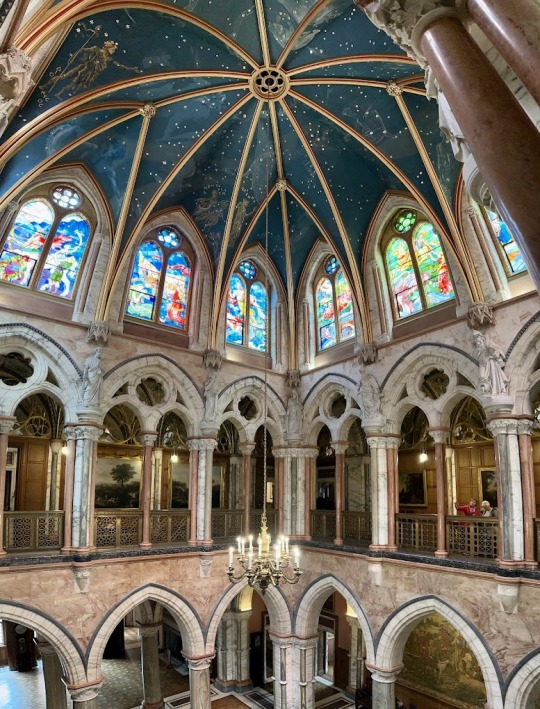
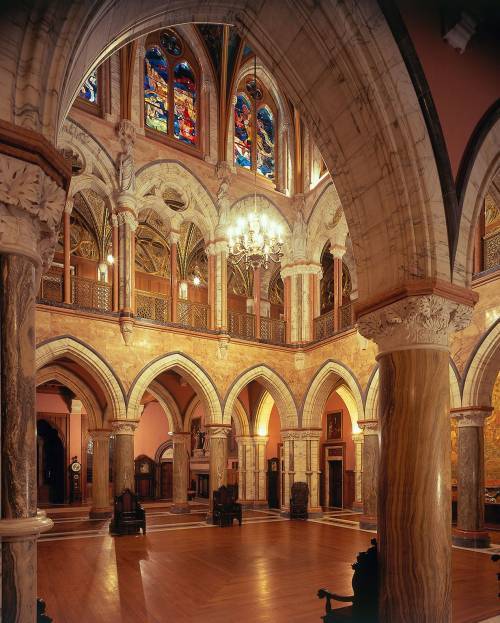
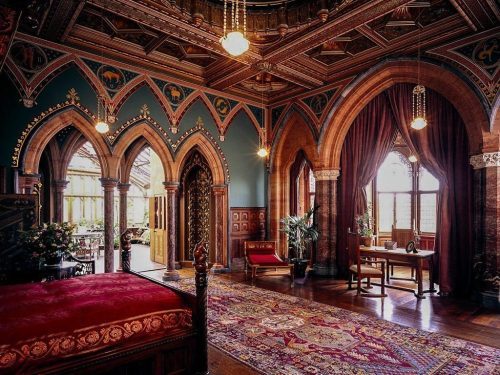
Mount Stuart is located on the east coast of the Isle of Bute in Scotland. The Gothic Revival country house was built in the 19th century. The house was built upon an earlier 18th century home severely damaged by a fire in 1877. The Georgian wings and much of the contents survived the fire and were incorporated into the new castle by the 3rd Marquess of Bute. The opulent interior boasts carved paneling, painted mirrors, a spiral staircase, a chapel, and much more. The Marble Hall has a map of stars on the ceiling and 12 stained glass windows depicting the signs of the zodiac moving through the seasons on the walls. The Gallery’s ceiling is decorated with winding branches from the Tree of Life, which frame the classical heads of 128 goddesses from ancient myth and legend. The house has collections of art and artifacts, including works by Ramsey, Reynolds, Gainsborough, as well as books, furniture, silverwork, porcelain, and Shakespeare’s First Folio. The estate has 300 acres of gardens that include a rock garden, a kitchen garden, an arboretum, and pinetums. The castle is used as a venue for weddings and corporate events. Mount Stuart can accommodate 37 guests in 22 separate areas around the house. There is a visitor center, a shop, and the Courtyard Café and Bakehouse.
21 notes
·
View notes
Text
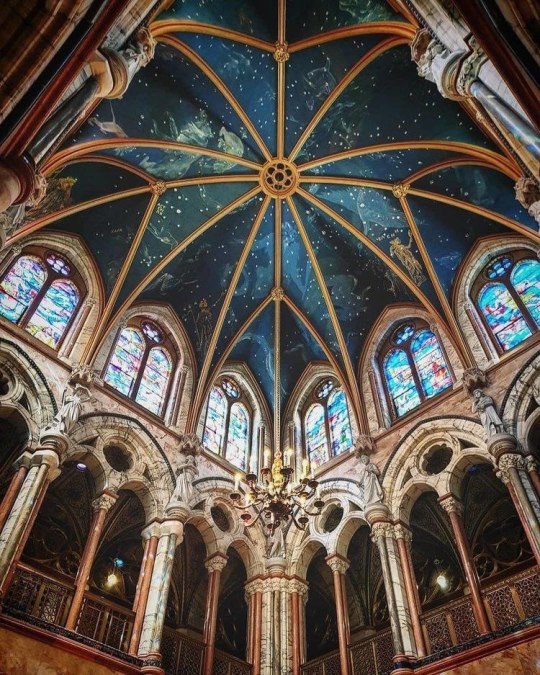
Mount Stuart House, Rothesay, Isle of Bute
#dark academia#light academia#academia aesthetic#classical#academia#escapism#classic literature#books#books and libraries#architecture#interior#royal core#cottage core#aesthetics#historical architecture
238 notes
·
View notes
Text


"3 SLAIN, 3 CAUGHT IN U. S. JAIL BREAK," New York Daily News. December 12, 1931. Page 2 & 4.
----
(By Associated Press)
LEAVENWORTH, Kan., Dec. 11. - Three escaped convicts in a farmhouse were killed, and three others were captured today after the six had kidnapped and wounded Warden Thomas B. White of the Leavenworth Federal Penitentiary. Prison authorities after a checkup tonight expressed the belief that a seventh prisoner, Earl Thayer, who was sent to the penitentiary from Oklahoma City for mail robbery with the convicts slain, also had escaped and is at large. Bloodhounds were used in an attempt to pick up Thayer's trail.
James Galvin, Assistant Deputy Warden, L. W. Mooney, prison guard, and an unidentified posseman were wounded, and one of the captured trio also was shot during the chase.
The dead:
Will Green, George Curtis, Grover C. Durrill, each under 25-year sentence from Oklahoma City for mail robbery. Each had served six years and eight months of their terms.
The captured:
Stanley Brown, sentenced from Fargo, N. D., for 15 years for robbing a post office, Tom Underwood, sentenced to a 25-year term from Duluth, Minn., for robbery of a post office with firearms, Charles Berta, sentenced from San Francisco, to a 25-year term for mail robbery. Berta was wounded.
First Kidnaped Warden.
The convicts abducted Warden White from his office this morning at the point of guns and escaped through the prison gate. They terrorized the countryside west of here and took several hostages, besides Warden White, in their flight. Officers and soldiers from Fort Leavenworth prison guards, Sheriff's off joined and unnamed citizens in running down the fugitives.
The slain men died in the farmhouse of E. C. Salsbury, 73, eight miles west of Leavenworth, while besieged by a posse which poured gunfire and tear gas bombs into their place of refuge.
Officers were uncertain whether the men killed themselves, seeing that capture was inevitable, or had been fatally wounded by shots from the outside.
Earlier, the other three had been captured in a gunfight in a patch of brush several miles away.
Warden Shot in Arm.
Warden White was struck in the left arm and side by a shotgun charge when he grappled with two of his captors. He was left by the side of a road where he fell. Physicians said tonight an operation had been performed and it was believed his arm would be saved.
In their flight from the prison the convicts commandeered three motor cars, disrupted classes at the Glen Valley School, where they forced the teacher, Mrs. Anna Mayer, to hand over the keys to her automobile, and terrorized farm families.
Airplanes from Fort Leavenworth participated in the manhunt, the aerial observers returning to the prison from time to time to drop messages.
Soldiers Aid Posse.
Major Gen. Stuart Heintzelman, in command of the fort, took a hand in aiding the prison authorities. Detachments of soldiers were made available to bring in the wounded, and details of men were assigned to the posses.
While the man hunt was on machine guns were mounted at every vantage point to be used in case of any outbreak within the prison.
Department of Justice Acts in Prison Break.
Washington, D. C., Dec. 11 (AP). - The Prison Bureau under Director Sanford Bates today began prompt study of the break which cost the lives of three Leavenworth prisoners.
Justice Department agents were dispatched to the prison.
Meantime, F. G. Zerrst, Assistant Warden who led the posse from the prison after the escaped convicts, was designated by officials here as acting warden.
(Other picture on page 1)
Photo captions:
Page 2
Three Leavenworth convicts who took part in escape (l. to r.), George Curtis, killed, Tom Underwood and Stanley Brown, captured.
The farm house near Leavenworth where three convicts died when cornered after escape yesterday.
WHERE BREAK FAILED
Airview of the Federal prison at Leavenworth from which seven prisoners made a bold attempt to escape yesterday. Three were killed, three captured and one is still sought.

New York Daily News. December 12, 1931. Page 1.
PRISONERS WATERLOO - Behind shattered windows of this farm house near Leavenworth, Kan., yesterday, three escaped convicts, cornered by posse, died by their own hands. Guards on balcony are dropping one convict gun to men below. Story on page 2.
#leavenworth penitentiary#prison break#escape from prison#escaped convicts#mail robber#train robber#train robbery#1931 leavenworth mass escape#the great depression#history of crime and punishment#police killing#shoot out with police#siege#sentenced to the penitentiary#armed robbers#armed robbery#federal bureau of prisons#leavenworth
0 notes
Text
The AM: December 11, 2023

After some initial cosmic digressions, it's a more guitar-forward episode of the AM, particularly in the last half, with dreamy tunes from Lush, the Haiduks, the Amazing, Ultimate Painting and more. Plus the story of a Christmas weed, and bright vibes for a dark winter day.
Listening links:
CJSW
Soundcloud
Spotify playlist
Hour One:
ekki hugsa
Ólafur Arnalds • It's 2am and I'm Not Tired
Pulse at the Centre of Being - Mor Elian Remix
Max Cooper • Unspoken Words Remixes III
Hungover and Late
Richard Reed Parry, featuring Stuart Bogie, Andrew Barr • Eileen OST
Sundogs
Mount Maxwell • Littlefolk
In the Soil
Various Artists, featuring Hermeneia & Zaumne • Always + Forever
Space Pop
Lars Deutsch • Boum Dans L'Espace
Nordlicht
Kosmischer Läufer • Volume Five
Airwaves
Kraftwerk • Radio-Activity
Dream Rain
Stilz • Single
Pure
Rich Aucoin • Synthetic: Season 2
Hour Two:
The Great Wave
Tristan De Liége x Jambal • Enterprises of Great Pith and Moment
Penthouse in Pernambuco
ATA Records • The Library Archive, Vol.3
Crescent Blade
The Budos Band • Frontier's Edge
Fried Neck Bones And Some Home Fries
Willie Bobo • Uno Dos Tres 1•2•3
For Free
Rogér Fahker • East of Any Place
Never the Bride
Raf Wilcot • Cinnabar Bouquet
Breathe Again
Dada Plan • A Dada Plan Is Free
Who’s the Thief???
Dada Plan • A Dada Plan is Free
Only the Lonely Know How
MOONRIIVR • Vol. 1
Dos Pasajeros
Melenas • Ahora
I Can’t Speak
La Luz • Weirdo Shrine
Shapes
Bong Wish • Hazy Road
Things I Hold
Knife Pleats • Hat Bark Beach
Cheerleader Coldfront (Guided By Voices Cover)
Lab Coast • Cover to Cover
Hour Three
Stop Trying (jubilant reprise)
siskiyou • Not Somewhere
Plain As Your Eyes Can See
Various Artists, featuring Acetone • Light in the Attic & Friends
Ten Street
Ultimate Painting • Ultimate Painting
Shelter
Alice Phoebe Lou • Shelter
I Have the Moon
Lush • Topolino
I’m Still Here
The Haiduks • 1968
Waiting for You
Sundays & Cybele • Gypsy House
Beau baptême
Population II • Électrons libres du québec
Occhi Malvagi
Futuropaco • Fortezza di Vetro, Vol. 1
Picture You
The Amazing • Picture You
0 notes
Text
Rephotography_'The 1990 Project'
Back in 1989 and 1990 the Auckland Public Library commissioned two projects to mark the national sesquicentenary a.k.a. 150 years since 1840 when Te Tiriti o Waitangi was signed and recognised as our founding document. This documentary initiative was named 'The 1990 Project', and aimed to record the look and feel of Auckland through oral history and documentary photography. (Jane Wild, Heritage Collections, Auckland Libraries)
The project involved five photographers: Stuart Page, Chris Matthews, Ans Westra, Miles Hargest and Paul McCredie. Photographed below on Queen St.

Image: Stuart Page. 1990 Project Photographers, Queen Street, 1989. Auckland Libraries Heritage Collections, 273-PAG057-22.
The series of over 6,000 images documented change in Auckland through the eyes of these five photographers and has since been a valuable comparison to see the kind of change occuring in our city.
The Auckland Central Library also holds collections of photographs, from the early to mid twentieth century, by photographers Henry Winkelmann and Rykenberg. Also with a more contemporary snapshot, the COVID collecting programme from 2020.
These photographs all document general change in Auckland but it is really interesting to see the snapshots that produce a timeline of change in the area I am interested in.
Though there are only a couple of the specific part of Roskill I have focused on, they show a change nonetheless. I would be really interested in getting re-shots of these scenes now.

Image: Miles Hargest. 1990 Project, Houses in Mount Roskill, 1990-93. Auckland Libraries Heritage Collections, 273-HAR079-05-PAN.

Image: Miles Hargest. 1990 Project, Manukau Harbour from Mount Roskill, 1990-93. Auckland Libraries Heritage Collections, 273-HAR079-12-PAN.



These are comparative images from the Roskill Development website (https://roskilldevelopment.co.nz)
0 notes
Text

The opulent Mount Stuart House on the Isle of Bute was unexpected. Recommended by the locals as a must see. Found out that this pleasure palace belonged the to Marquesses of Bute. The same family that used to live at the Cardiff Castle in Wales. The interior is just as whimsical and beautiful like Cardiff Castle. A lot of referrals to astrology and mysticisms. This is seen through its tinted-glass windows and symbolism in its architecture. The chapel within Mount Stuart House is white marble
#original photography#australian photography#photographers on tumblr#australian photographer#original photographer#travel photography#nature#travel#travel blog#Mount Stuart House#Isle of bute#Scotland#UK#architecture#gothic architecture#Marquesses of Bute#opulence#history#astrology#whimsical#white marble
4 notes
·
View notes
Text
I can only imagine how n'ice e-z floe...
Tubby in the calving throes
breaking free and clear
shepherding, milking, and honing
rambunctious as bovine bris
versus being stymied courtesy
cow - wordly bull aiming writer's block
for drought of creativity.
Asper this instance,
when a dearth of ideas
like a charred bait oven
finds me (a Brahms man) looking Bach
at drawing board and/or the clock
as if inspiration
can be found teasing out
whimsical child like spontaneity
recalling hickory dickory dock
rather than exacerbate
mental paralysis, akin
to an invisible vice grip,
which tension eventually
far worse than bill
lee esse ness, which former
grips with irony my chin,
I try release -
singsong restraint and chill,
ready to whip out power drill
not surprised finding sawdust,
viz of course after numbing skull
sticking head in deep freeze
or mounting temple
on dry ice, without
receiving nary a cavil
lack of creative noggin fill
intense concentration
invariably heats up "thinker"
as if being scalded,
skewered, sussed out
on a barbecue grill,
(which fixed attention),
never ever engenders
positive flow of ideas,
but absolutely ideal
for reducing a molehill
from a mountain dew,
nevertheless within ma mind,
before long prolonged
cessation to brainstorm induces ill
humor succumbing into
torturous mental state
(fall of the cider
house rules usher),
non poe whet
tick dark age,
whar ah felt jill
ted loom min hated
with panic ready to kill...
mice elf (cue Stuart Little),
cuz dem lil
cerebral cogs and wheels
malfunction for more'n a mill
yen times prompting
to scout graveyards
for fresh corpse, and lovely bones
if results rendered nill
jet over to Doctor Frankenstein,
even if aye gotta
hightail to Trans sill
vein ya, unless....
perhaps ye kind reader twill
donate yar viable gray matter tummy
(right after ya die) denny ya will
almost be him morte till!
0 notes
Video
youtube
Culloden
"Culloden" Scottish Jacobite Rebellion, The 1964 Classic Docu-Drama . The Battle of Culloden was the final confrontation of the 1745 Jacobite Rising. On 16 April 1746, the Jacobite forces of Charles Edward Stuart fought loyalist troops commanded by William Augustus, Duke of Cumberland near Inverness in the Scottish Highlands. The Hanoverian victory at Culloden decisively halted the Jacobite intent to overthrow the House of Hanover and restore the House of Stuart to the British throne; Charles Stuart never mounted any further attempts to challenge Hanoverian power in Great Britain. The conflict was the last pitched battle fought on British soil.
1 note
·
View note
Text


Brigadier General Hugh Mercer died on January 12th 1777 after being wounded at the Battle of Princeton.
Historians argue that, had it not been for his untimely and grisly death at the Battle of Princeton in 1777, Hugh Mercer, born in Aberdeenshire, would have been a greater leader than Washington and would rank as one of the greatest American heroes of all time.
Born on January 17h, 1726, at the manse of Pitsligo Kirk in Roseharty, Scotland, Hugh Mercer was the son of Reverend William Mercer and his wife Ann. At the age of 15, he left home to attend Marischal College at the University of Aberdeen to study medicine. Graduating as a doctor, he practiced locally until the arrival of Prince Charles Edward Stuart and the beginning of the 1745 Jacobite Uprising.
Rallying to the Prince’s colours, Mercer became an assistant surgeon in the Jacobite Army. He remained in this service until the Battle of Culloden. Mercer was forced to flee Scotland for America in 1747. Arriving in Philadelphia, he settled on the Pennsylvania frontier and returned to practising medicine. by 1758 he was, like many Scots who fled, serving in the British army, battling Shawnee and Delaware Indians, Mercer and his men took part in Lt. Colonel John Armstrong’s raid on Kittanning on September 8th, 1756. and became separated from his men. Alone following the battle, he made his way 100 miles on foot back to Fort Shirley where he received medical attention and was heralded a hero and promoted to the rank of Captain, it was here that Mercer was to become good friends with a man that would shape the remaining years of his life, also a Colonel at the time, his name was George Washington.
Before you start questioning his loyalty with being in the British army remember Washington was also in their pay at this time. After the 7 year war he settled back into private practice but 15 years later was elected as a Colonel of the Minute Men of Spotsylvania a Militia that would play an important part in the American Revolution, he had initially excluded from the elected leadership and branded a “northern Briton,” later being appointed Colonel in the Virginia Line part of the Continental Army which rose in revolt against British rule after the outbreak of the American Revolutionary War, once again he was fighting against “the auld enemy”.
One of the officers under Mercer was future president James Monroe. He rode through the ranks to Brigadier General distinguishing himself and involving himself with George Washington battle plans until January 3rd while on their way to The Battle of Princeton leading a vanguard of 350 soldiers, Mercer’s brigade encountered two British regiments and a mounted unit. A fight broke out at an orchard grove and Mercer’s horse was shot from under him. Getting to his feet, he was quickly surrounded by British troops who mistook him for George Washington and ordered him to surrender. Outnumbered, he drew his saber and began an unequal contest. He was finally beaten to the ground, then bayoneted repeatedly—seven times—and left for dead.
When Washington learned of the British attack and saw some of Mercer’s men in retreat, he himself entered the fray. Washington rallied Mercer’s men and pushed back the British regiments, but Mercer had been left on the field to die with multiple wounds to his body and blows to his head. (Legend has it that a beaten Mercer, with a bayonet still impaled in him, did not want to leave his men and the battle and was given a place to rest on a white oak tree’s trunk, while those who remained with him stood their ground. The tree became known as “the Mercer Oak” and is the key element of the seal of Mercer County, New Jersey.
When he was discovered, Mercer was carried to the field hospital in the Thomas Clarke House (now a museum) at the eastern end of the battlefield. In spite of medical efforts by Benjamin Rush, Mercer was mortally wounded and died nine days later on January 12, 1777.
In 1840 he was re-buried at Philadelphia’s Laurel Hill Cemetery. Because of Mercer’s courage and sacrifice, Washington was able to proceed into Princeton and defeat the British forces there. He then moved and quartered his forces to Morristown in victory.
The second picture show a painting entitled George Washington at Battle of Princeton features in the foreground Hugh Mercer lying mortally wounded in the background, supported by Dr. Benjamin Rush and Major George Lewis holding the American flag. This portrait is the prize possession of Princeton University.
16 notes
·
View notes
Photo

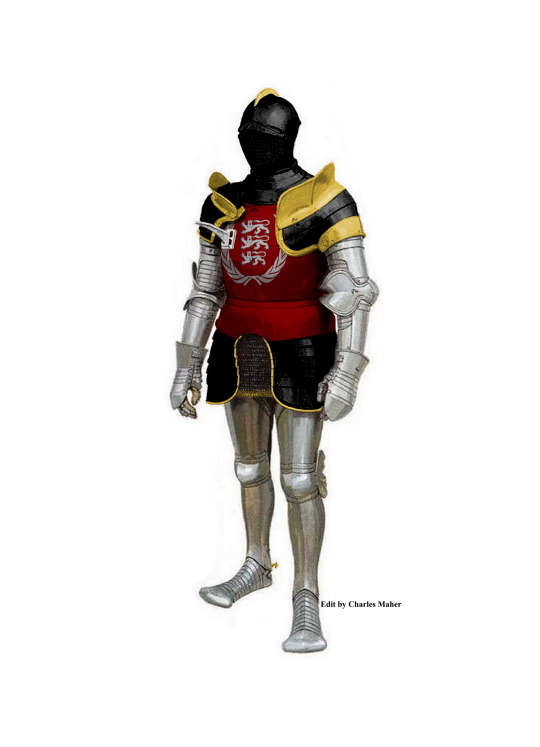
My latest illustration of a knight I retouched to feature the signature colours and faction iconography of “House Lyonheart,” the ruling, dynastic house of “The Kingdom of Albion” in my low-fantasy setting. Both this artwork and it’s associated faction iconography were designed for a low-fantasy world of my original conception, with technology and material culture roughly equivalent to the late medieval and renaissance periods of European history. Where formations of heavily armoured and mounted knights in either suits of full plate armour or heavy coats of chainmail fight alongside professional armies of pikemen and matchlock musketeers. Where medieval-style stone castles are gradually being outsourced in favour of both sumptuous country estates and devoted military fortifications, or “bastions,” due to the technological advancements being made in artillery design. And where fledgling nation-states in the form of both kingdoms and empires look beyond the great oceans and the frontiers of the known world in search of even greater wealth and territory.
In context to the canon lore of my low-fantasy world, “House Lyonheart” is the reigning, dynastic house of “The Kingdom of Albion.” An island kingdom loosely inspired by late medieval and early modern England under the Lancaster, Tudor, and Stuart kings, while also drawing fictional sources of inspiration from “Ulthuan,” or the land of the “Asur” or “High Elves” from Warhammer Fantasy as well as “The Kingdom of The Westerlands” under House Lannister in Game of Thrones. “The Kingdom of Albion,” under the hereditary, dynastic rule of the kings of “House Lyonheart,” practices a limited from of consensual government known as “constitutional monarchy.” An unusual form of monarchy where the military, executive, legislative, and fiscal power and authority of the Kings of Albion from House Lyonheart are limited by the constitutional “rule of law,” ultimately derived from the voluminous bodies of “Albionic Common Law” and governed by the constitutional mandates of “The Magna Rhetra” as well as thoroughly regulated by a bicameral legislative body known as “parliament.” Albionic Parliament as the chief, national, legislative body of The Kingdom of Albion consists of an upper “House of Lords” containing official representatives of the greater and lesser dynastic houses of feudal aristocracy and nobility within The Kingdom of Albion, as well as high-ranking ecclesiastical and monastic offices of “The Conservative Church of The New Gods” as the official, state religion of The Kingdom of Albion, as well as a lower “House of Commons,” containing elected representatives of the country gentlemen, the bourgeoisie, and the merchant guilds within The Kingdom of Albion. “The House of Lords” as the senior, upper legislative house of Albionic Parliament was officially formed in the aftermath of a baronial revolt against Edward Shortsword as the 31st King of Albion and Head of House Lyonheart following his calamitous and failed “Wars of Aquitanian Succession” to usurp Maison Williamson as the reigning, dynastic house of Aquitanian Monarchs, alongside the subsequent drafting of “The Magna Rhetra” as a codified constitution governing the voluminous bodies of “Albionic Common Law” that were first codified and implemented by Albionic court scribes and clergymen under the reign of “Artorius the Lyonhearted” as the culturally Southern Aquitanian son and heir apparent to “Hengist Skullsmasher,” The First King of Albion and The Founding Head of House Lyonheart. “The House of Commons” as the lower, junior legislative house of Albionic Parliament, by contrast, was officially formed during the reign of Robert III as the 40th and late King of Albion and the former head of House Lyonheart in the wake of a massive peasant uprising agitated by over 10 years of brutal taxation to repay the extortionate king’s ransom imposed on Robert III by the court representatives of Maison Williamson as the reigning, dynastic household of Aquitanian Monarchs following his capture by the forces of Prince Tancred Williamson, Duc de Chambord in The Battle of Tourangeau, and the subsequent drafting of “The Treaty of Fontainebleau” officially concluding the last Albionic invasion of Le Royaume d’Aquitaine.
The Kingdom of Albion’s system of constitutional monarchy and parliamentary legislature is a truly unique and exclusive model of government and society in a world where all monarchs and hereditary, dynastic princes based on the continental mainland of “The Civilized World” aspire to the example of “Maison Williamson du Royaume d’Aquitaine” as the “paragon,” “exemplar,” “ideal,” or otherwise “model” of a strong, powerful, prestigious, prolific, and illustrious “absolute monarchy.” A model of absolute monarchy that is distinctly characterized by a combination of their ancient, carefully cultivated and manicured political and religious alliance forged with “The Conservative Church of The New Gods” based in The Holy Sept of Romulus as the former capital, civilizational kernel, and titular namesake of both The Cosmopolitan, Classical Romulan Republic and “The Empire of Mankind Primus” that once dominated the vast majority of “The Known World” during the long forgotten epoch of “Classical Antiquity.” The superimposition of “The Aquitanian Parlements,” or “royal law courts,” over the provincial jurisdiction of both the feudal, aristocratic, legal traditions and customs of Northern Aquitaine, which collectively descend from the synthesis of Teutogen Tribal Customs with Cosmopolitan, Classical Romulan legal traditions and jurisprudence, as well as the old, Classical Romulan law codes of Southern Aquitaine. With both forms of Regional Aquitanian Law being ultimately left over from the closing centuries of The Cosmopolitan, Classical Romulan “Empire of Mankind Primus” and it’s gradual, eventual collapse at the hands of Teutogen, Norscan, and Moravian tribal invaders during the twilight of “Classical Antiquity” in the long and storied, recorded histories of “The Civilized World.” And the creation of The Civilized World’s first national, professional, state-funded, “royal” army since the historic mass mutiny and the consequent, official dissolution of The Romulan Legions of Classical Antiquity under the Classical Romulan Imperator of Mankind “Demetrius Superbus” as the Classical Romulan Imperator who first prescribed “The Faith of The New Gods” based on the old, Classical Romulan rite and liturgy originally formalized and decreed in the theological reforms traditionally attributed to the Classical Romulan Imperator of Mankind “Cassadorian the Great” as the official “state religion” of The Cosmopolitan, Classical Romulan “Empire of Mankind Primus.” His official founding of “The Conservative Church of The New Gods” as an administrative institution, or “organ,” within the civil magistracy of The Classical Romulan Empire of Mankind, and his equally historical and infamous “land donation” with the consequent consecration and the construction of the first “Holy Sept” in Romulus. The Kingdom of Aquitaine’s national, professional, state-funded, “royal army” was created using the administrative, legislative, and fiscal power and support of “The Aquitanian Parlements,” or “royal law courts,” at the expense of the feudal, private, aristocratic levies of Le Royaume d’Aquitaine’s “great houses” of “feudal princeps” or “feudal magnates.”
Although officially subscribed to “The Conservative Church of The New Gods” based on the old, Classical Romulan rite and liturgy originally formalized and decreed under the Classical Romulan Imperator of Mankind “Cassadorian the Great” during his “Cassadorian Reforms,” and officially seated within “The Holy Sept” of the old capital, civilizational nucleus, and titular namesake of The Cosmopolitan, Classical Romulan Republic and “The Empire of Mankind Primus” since the original founding of The Conservative Church of The New Gods as an administrative institution, or “organ” within the Classical Romulan civil magistracy by the Classical Romulan Imperator of Mankind “Demetrius Superbus.” The Kingdom of Albion under the hereditary reign of Edmund IV as The 41st and Reigning King of Albion and The Current Head of House Lyonheart has officially opened The Kingdom of Albion’s borders to religious asylum for any religious subscribers to The “Reformed” Faith of The New Gods based on the theological reforms officially preached and published by Karl Von Luxembourg, a learned doctor of theology based at The University of Wörtzburch within The Empire of Mankind Proper, as well as the former heir apparent and the official head of “Hohenluxembourg Des K��nigreich Schönbrunn.” The only hereditary monarchy within The Empire of Mankind Secundus besides “the hereditary state” and “the dynastic house” of The Emperor-Elect, himself. As well as religious subscribers to any of The “Dissenter” Faiths of The New Gods ideologically descended from “The Dissenter Theology” of the Aquitanian vagabond Cassyon Dufresne, a more radical theological reformer officially seated in The Cathedral of Les Œillets in “The Borderlands Confederacy” of culturally “Austere” or “Northern Imperial” states strategically situated between “Der Reichstaat” or “Nymphenburg” as the hereditary state of “The Imperial Household.” “The Exclusive” or otherwise “the preferential” candidates for the formal elections for the title of “Emperor of Mankind,” and “Die Markgrafschaft Brannenborg” under “Hohenbiermann.” The last, and arguably the most reluctant constituent member state and hereditary, dynastic, “great house” of “Imperial Princeps” or “Imperial Magnates” within The Empire of Mankind Proper since the stunning and final conclusion of “The Albic Crusade” waged against the apostate, Albic tribes religiously subscribed to the druidic, cult worship of “Erdøk” or “The Great Forest” east of The Empire of Mankind Proper and indigenous to “The Southern Imperial March” or “Die Sudetenmark.” The climactic “Siege of Brenna,” and the consequential, de jure installment of the great Imperial general Friedrich Biermann as “Der erster Markgraf von Brannenborg und Der Gründungschef von Hohenbiermann” over the lands originally pawned and then permanently transferred by the illegitimate issue of The Late House Bartholemew as The Last King of The Midlands to “The Imperial Household” as the hereditary, “Imperial Princeps” or “Imperial Magnates” for “Der Reichstaat” or “Nymphenburg.” Despite officially opening The Kingdom of Albion’s borders to religious asylum for any religious subscribers to the multitude, or the plethora of “Reformed” and “Dissenter” churches of The New Gods fleeing religious persecution and marginalization at the hands of religiously Conservative monarchs and aristocrats. The fourteen year old Edmund IV had already been officially proclaimed as “The Defender of The Faith” by the elderly and ailing Archpatriarch Vexillarius IV as “The 299th and Reigning Bishop of Romulus” and “The Current Head of The Conservative Church of The New Gods” for his written thesis’ openly condemning the theological reforms of Karl Von Luxembourg as the titular “Great Reformer” to the religious establishment of, and the institutions of organized religion within The Conservative Church of The New Gods, as well as Edmund IV’s own maternal grandfather Friedrich I, “Der erster und herrschend König von Middenland und Der Gründungschef von Hohenrotbart” and his older cousin Albrecht Von Biermann, “Der herrschend Markgraf von Brannenborg,” “Der momentan Chef von Hohenbiermann,” and secular, hereditary “Kurfürst Des Selbst Kaiserreich der Menscheit” for their combined actions in both forcibly and unlawfully confiscating the lands, property, and treasuries of any ecclesiastical and monastic clergy of The Conservative Church of The New Gods based within Das Königreich Middenland and Die Markgrafschaft Brannenborg, respectively, for openly refusing to submit before the formal renunciation of their spiritual ties of fealty to The Holy Sept in Romulus as the first and second hereditary, dynastic rulers in both the recorded histories and the geographic enormity of “The Known World” to formally decree state legislation to officially convert to “The Luxembourgian Reformation” on behalf of both their houses and their subjects.
The Kingdom of Albion’s unique and exclusive model of “constitutional monarchy” and “parliamentary legislature,” although severely limiting the military, executive, legislative, fiscal, and religious ambitions of House Lyonheart as the reigning dynasty of Kings of Albion. Especially by contrast to the aspiring absolute monarchies and aristocracies based on the continental mainland of “The Civilized World.” The hereditary subjects to The Kings of Albion from House Lyonheart are unironically exempt from all the extortionate taxation and brutal economic recessions that inherently coincide with the perpetual warfare, cutthroat political intrigues, and brutal religious upheaval that characterize daily life on the continental mainland of The Civilized World. With Albionic Parliament’s persistence on consistently vetoing any taxation officially levied by state representatives of the crown in order to fuel House Lyonheart’s continental ambitions. Edmund IV as The 41st and Reigning King of Albion and The Current Head of House Lyonheart has used the legal restrictions imposed upon him by the constitutional mandates of The Magna Rhetra and Albionic Parliament to conceive of a policy of overseas colonialism and maritime trade. By granting “letters of marque” or “colonial charters” to “trade companies” of merchants, traders, and professionals willing to invest their own capital in order to found and develop colonies and territories in overseas trade theatres, Edmund IV, as The 41st and Reigning King of Albion and The Current Head of House Lyonheart has essentially developed a far more efficient, or otherwise effective alternative policy to pursing House Lyonheart’s traditional, historic military and territorial ambitions against the monarchs and princes based on the continental mainland of “The Civilized World.” A policy that Albionic Parliament, and above all the country gentlemen, bourgeoisie, and merchant guilds collectively represented within the lower, junior “House of Commons” are far more willing to support as the chief, national, legislative body of The Kingdom of Albion. These “letters of marque” or “colonial charters,” as officially granted by Edmund IV as The 41st and Reigning King of Albion and The Current Head of House Lyonheart would essentially grant “trade companies” of merchants, traders, and professionals legally exclusive monopolies in overseas trade theatres to found and develop overseas colonies and territories in order to facilitate maritime trade back with The Kingdom of Albion, while also being granted a significant degree of political and military autonomy over any acquired and developed overseas colonial territories. Amongst the largest, most lucrative overseas colonial possessions officially founded and developed by The Kingdom of Albion’s and House Lyonheart’s “trade companies” include “New Albion” under “The King’s Landing Trade Company,” as well as “Arcadia” under “The World’s End Trade Company.” To secure the lucrative trade established between any overseas colonies and territories officially founded and developed by his majesty’s “trade companies” with The Kingdom of Albion, Edmund IV as The 41st and Reigning King of Albion and The Current Head of House Lyonheart has diverted most of the annual, national, state budget for The Kingdom of Albion’s traditionally strong, standing military in favour of founding and developing a national, professional, state-funded, “royal” navy, in contradiction to the traditional and historical policies of all Kings of Albion before him. Edmund IV has also “subsidized,” or otherwise “invested in” local merchant guilds devoted to the construction of ships and the production of maritime goods and resources on an industrial scale to give both his growing professional navy and his trade companies the necessary assets they need in order to both secure and facilitate the lucrative trade established between any acquired and developed overseas colonies and territories with The Kingdom of Albion, itself.
Despite, or rather because of Edmund IV’s policy of overseas colonialism and maritime trade, as well as the necessity of both financing and developing a growing professional navy at the expense of The Kingdom of Albion’s traditionally strong, standing army. Specifically for the purpose of securing any maritime trade lanes officially established between The Kingdom of Albion with it’s multitude, or plethora of overseas colonial possessions. The Kingdom of Albion under the hereditary, dynastic reign of House Lyonheart oddly continues to employ peasant levies of billmen and longbowmen in an age where both the continental, mainland states of “The Civilized World,” as well as their reigning, dynastic houses of monarchs and aristocratic princes have moved on to employing professional regiments of pikemen and matchlock musketeers as the line, core, and bulk of their campaigning armies. However, in likeness to the continental states based on the mainland of “The Civilized World,” as well as the reigning, dynastic houses that rule them. The Kingdom of Albion under the hereditary, dynastic rule of House Lyonheart has successfully outsourced it’s antiquated arsenal of classical and feudal-style windlass artillery pieces such as ballistae, catapults, trebuchets, mangonels, and onagers with the more novel, yet far more potent and brutally efficient gunpowder-based, siege artillery pieces such as bombards, culverins, mortars, chambered demi-cannons, and even the dreaded “basilisks.” Despite the seemingly antiquated military technology and tactics employed by the infantry regiments serving both House Lyonheart in particular, and The Kingdom of Albion in general. The peasant levies of billmen and longbowmen indigenous to The Kingdom of Albion more often than not rival, if not occasionally outperform the more modern, professional, pike-and-shotte infantry regiments employed by both the continental powers of The Civilized World and the reigning, dynastic houses that rule them. Most notably those employed by “Maison Williamson du Royaume d’Aquitaine,” as well as “Die Sudkreuzritterstaaten,” or “The Teutogen” or “Southern Austere” cultural and linguistic bloc of hereditary, dynastic states such as “Hohenrotbart Des Königreich Middenland” and “Hohenbiermann Der Markgrafschaft Brannenborg.”
#coats of arms#heraldry#shields#medieval#renaissance#chivalry#knights#plate armour#chainmail#painted armour#black armour#blackened plate#gilding#burning#fantasy#fantasy world#graphic design#art#Robert III#Edmund IV#Kaitlin Lyonheart#Edward Fitzroy
0 notes
Photo

Old High Church Kirkyard in Inverness, Scotland
Following the Scottish defeat at Culloden, this graveyard became a “killing field.” Perched on St. Michael’s Mount overlooking the River Ness, the Old High St. Stephen’s Church is the oldest church in Inverness, Scotland. It's been a place of worship since the Irish missionary St. Columba visited the Scottish Highlands in the 6th Century. It is believed to be where he converted the Pictish King Brude to Christianity in 565. Much of the current building was constructed in 1770, but the church tower base dates to at least the 1300s, making it the oldest standing building in Inverness. Although a place of worship and devotion for centuries, the Old High Church’s Kirkyard, the graveyard beside the church, was the site of an atrocity following the Battle of Culloden on April 16, 1746. The battle lasted less than an hour. English forces decisively defeated the Jacobite army of Charles Edward Stuart, a.k.a. Bonnie Prince Charlie, marking the end of the Jacobite Uprising of 1745 and all efforts to restore a Stuart king to the throne of England and Scotland. Following the devastating loss, hundreds of Jacobite prisoners were brought to Inverness, some of whom were then imprisoned in the tower of the Old High Church. Many of the Jacobite prisoners were wounded or ill. The conditions were harsh, and those not already sick soon weakened from cold and starvation. Rather than transport the Scottish prisoners to England, many were hastily tried and sentenced in the Church and then executed among the graves in the Old High Church Kirkyard. A firing squad executed condemned prisoners in front of the stone masonry outside the blue-painted door of the Church tower. Divots from errant musket balls still pockmark the tower's wall. Prisoners unable to walk or stand were taken to the center of the Kirkyard and seated against a gravestone. A direct ten paces from that gravestone was another whose top featured a heart-shaped cleft. A sharpshooter would lay behind the second stone and use its notch to steady their musket before firing at the injured condemned soldier. The Kirkyard’s stone wall stopped any stray bullets. Balnain House, a Georgian townhouse directly across the river from the Old High Church, was used as an English field hospital following the Highland battles. Wounded Hanoverian officers recuperating there watched the Kirkyard executions from their hospital windows. How many prisoners died at the Old High Church and how the English disposed of the bodies is unknown. Some believe that the prisoners executed at the Old High Church were buried in a pit beneath what is now a paved walkway next to the Church.
https://www.atlasobscura.com/places/old-high-church-kirkyard
#warriors#war#war history#prisons#execution#murder#graves#gravestones#graveyards#churches#Atlas Obscura
0 notes
Photo

30 notes
·
View notes